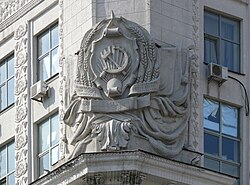Decommunization in Ukraine
[11] By December 2015, these parties had been banned, for involvement in violating Ukraine's sovereignty and territorial integrity, inciting a violent overthrow of the state, and supporting Russian proxy forces.
[17] Ukraine's first president after the country's 1991 independence from the Soviet Union, Leonid Kravchuk, had also issued orders aimed at "de-sovietisation" in the early 1990s.
[5] In April 2014, a year before the formal, nationwide decommunization process in Ukraine local authorities removed and altered communist symbols and place names, as in Dnipropetrovsk.
[23][24] One of the main provisions of the bill was the recognition of the Soviet Union's regime as "criminal" and one that "pursued a state terror policy".
[2] The ban on communist symbols did result in the removal of hundreds of statues, the replacement of street signs and the renaming of populated places including some of Ukraine's biggest cities like Dnipro.
[18] The legislation also granted special legal status to veterans of the "struggle for Ukrainian independence" from 1917 to 1991 (the lifespan of the Soviet Union).
[4] This started a six-month period for the removal of communist monuments and renaming of public places named after communist-related themes.
[32] On 16 December 2015, the Kyiv District Administrative Court validated the claim of the Ministry of Justice in full, banning the activities of the Communist Party of Ukraine.
[14] In March 2016, statues of Lenin, Felix Dzerzhinsky, Sergey Kirov and a Komsomol monument were removed or taken down in the eastern city of Zaporizhzhia.
"[42] In May 2017, 46 Ukrainian MPs, mainly from the Opposition Bloc faction, appealed to the Constitutional Court of Ukraine to declare the 2015 decommunization laws unconstitutional.
[43] Director of the Ukrainian Institute of National Remembrance Volodymyr Viatrovych stated in February 2018 that "De-communism in the context of depriving the symbols of the totalitarian regime has actually been completed".
[43] On 7 November 2020 in the village Mala Rohan, an Emblem of the Ukrainian Soviet Socialist Republic was dismantled from the facade of a school.
[48] On 1 August 2023, the Soviet emblem was removed from the Motherland Monument (part of the National Museum of the History of Ukraine in the Second World War) in Kyiv.
[9] The Kharkiv Human Rights Protection Group stated (in May 2015) the laws "(one of which) effectively criminalizes public expression of views held by many Ukrainians".
[55] In April 2015, Russian lawmakers claimed that it was "cynical" to put communist and Nazi symbol on par with each other, and Russian-backed paramilitaries have condemned the law.
[citation needed] However, the April 2015 decommunization law contains a norm that allows the Ministry of Justice to prohibit the Communist Party from participating in elections.
In the second-largest city of Ukraine,[61] Kharkiv, more than 200 streets, 5 administrative raions, 4 parks and 1 metro station had been renamed by early February 2016.
[65] In January 2021 "Radio Free Europe/Radio Liberty" located three remaining Lenin statues in three (Ukrainian controlled) small villages.
The last Lenin statue in Ukraine (excluding territories currently annexed by Russia or occupied by separatists) was demolished in Stari Troyany, Izmail Raion, Odesa Oblast on 27 January 2021.
[73] As of 8 April 2022, according to a poll by the sociological group Rating, 76% of Ukrainians support the initiative to rename streets and other objects whose names are associated with the Soviet Union and Russia after the Russian invasion of Ukraine.



